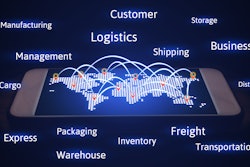
Profitability and sustainability are becoming more interconnected, but supply chain upheavals and shifting consumer patterns can make long-term investment seem difficult for manufacturers to achieve. To identify valuable, reasonable targets, manufacturers may need to look at supply chain pressures to see how others are responding to identify elements that also impact sustainability goals.
There’s a lot of work to be done to protect supply chains from the next black swan, but actions like improving resilience, adding partners, and enhancing relationships via product offerings may also have green potential.
Available and Unavailable Transport
References to “supply chain changes” often feel like a veiled note that everything seems to be getting delayed during transit. Full trailers, a lack of containers, port delays, rail strikes, and more all seem to be getting in the way. For manufacturers, that can mean restrictions on options for getting inbound materials and pushing products to port.
That overall reduction in availability — and cycles that could mean limited availability are again around the corner — highlights the need to optimize freight. That’s particularly true because many manufacturers have needed to use whatever mode was immediately available. Expediting freight, changing carriers, or switching modes all run the risk of increasing your carbon footprint. Pushing at that speed creates challenges for meeting sustainability goals.
With certainty remaining elusive, it’s time to retool your efforts on packaging. Look for options to reduce packaging and avoid overuse or packing. Consider refreshing designs to minimize elements or combine units to maximize pack-to-product ratios. This can be difficult for large and heavy goods. In these cases, look for sustainable partnerships. Reusing and reclaiming pallets or increasing efforts to capture scrap materials for recycling can help you stick to sustainability efforts and goals.
Optimize the processes and relationships you can control directly to hedge your bets against changes outside your hands.
Stockouts and small batch pressures
For consumers, supply chain issues often mean fewer products on store shelves or greater delays in getting their favorite things. Some manufacturers are experiencing similar stockouts of materials and components. In 2022, the world added recessions and inflationary pressures to the mix just to keep everyone on their toes.
Many CPG brands have responded by adjusting packaging and container volumes to sell a little bit less in a familiar shape. While not all consumers are happy with this shrinkage, they’re still buying. Internal and third-party manufacturing can support this shift and improve sustainability efforts by using this as an opportunity to increase investment in sustainable product designs. Not only might you reduce overall plastics, but potentially shift to up-cyclable materials, reduce waste products, and improve reusability by consumers.
Prolonging shelf-life through package manufacturing, for instance, can also help you to be part of reducing food waste. That’s a net green win.
If you make these changes, why not shift freight packaging and container use to fit greater product numbers in each shipment? This might be the right time to rethink your AI and machine learning utilization to see if there are real-time production data or processes that could be improved or may be getting in the way of your overall sustainability practices.
Near-Shoring and Partner Expansion
While most supply chain news is focused on efforts downstream of manufacturing, don’t neglect your upstream partners. While customers are likely reviewing contracts and partnerships, consider your own for parts, raw materials, and equipment. Can you take advantage of near-shoring efforts to reduce inbound costs of components? Or are all current suppliers region-locked so that any disrupting force is likely to impact all of them at once?
Have you had difficulty scaling up your inventories with current suppliers? Can new partners improve quality or quantity?
Your customers are focused on scaling while controlling costs, and that’s starting discussions for near-shoring and reshoring their partnerships. Those discussions take years to come to fruition. In the meantime, they’re focused on increasing inventory holding to creation protection when they can make a change.
Look for opportunities to do the same for your operations, or to find additional partners that address potential customer concerns. If you become the manufacturer that is less susceptible to the next regional or global shift, you become a more attractive partner.
Look Outside Current Production
A supply chain focus can limit our vision of sustainability efforts. If your operations need to take drastic steps to keep goods moving, look beyond that production to see if there are options to improve overall sustainability.
Turn to the trends COVID brought to see if you have other opportunities. These vary greatly by region but may include:
- Capitalizing on the growth of renewable energy, such as solar and wind.
- Allowing HQ and office staff to work remotely.
- Replace, repair, and update equipment — from machinery to the dishwasher in the break room — to energy-efficient models.
- Adapt materials to support circular manufacturing.
- Rent needed equipment from others or rent out your unused equipment to reduce the needs of others to buy new.
- Digitize internal communications to limit paper use and reach your entire team.
- Switch required non-production materials to greener alternatives — think cleaning, office supplies, and the food you offer.
- Can you retrofit facilities or add elements like cooling towers to save water.
Communication and Presentation
At the crux of nearly every supply chain issue and pressure of the past few years has been communication — often overlooked or poorly performed. Slow messaging or a lack of proactive communications exacerbated many issues by delaying the speed at which companies could respond. The shift from lean, just-in-time inventory strategies to just-in-case inventory scaling was pushed by difficulties in understanding issues and addressing them.
Sustainability issues can face the same challenges. You’ve spent years and significant capital in creating programs, running data to understand emissions or footprints properly, and developing a long-term strategy. Now, you need to learn how to communicate and share your work.
Focus on being proactive and addressing issues and opportunities as early as possible. Use the supply chain issues you’ve likely had — such as unexpected delays in raw materials — to frame what you share and how. Highlight backup plans and alternatives, show multiple partners and sources for sustainability, and give clear insights.
Communication is how you make your efforts clear and get your staff and customers to care about these initiatives. Manage sustainable communication as you would any other component of your effort so that you get credit and can continually improve.
Jake Rheude is the Vice President of Marketing for Red Stag Fulfillment, an eCommerce fulfillment warehouse.





















